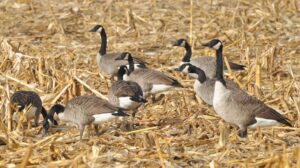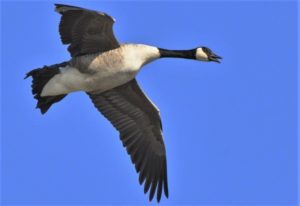Photography courtesy of Lowell Washburn, all rights reserved.
If I had to choose just one single month as my favorite, that month would have to be October. October is a time of incredible beauty. Fall colors have reached their peak, and the air is heady with the scent of autumn. The October weather seems to agree with everyone. Generally speaking, the mornings are crisp and cool. The afternoons warm and sunny. And if we haven’t had a killing frost yet, we soon will.
For the Iowa outdoor enthusiast, the list of things to see and do seem endless. But the thing I love most about October are the Canada geese. By now, the fall grain harvest is in full swing, a fact that does not go unnoticed by these giant waterfowl. Following a summer of grazing like cattle, the birds’ collective appetites have quickly transitioned from grass to the high carb nutrition found in recently cut fields of corn and soybeans. With mild temperatures and an endless supply of food, the livin’ is easy. Slabbing it on for winter, the geese grow heavier with each passing day.
Although most of the geese we’re currently seeing are homegrown, populations will soon become homogenized with migrants from the north. Canada geese are represented by many subspecies. Some migrants will arrive from the wetlands of Ontario and Manitoba. For others, the migration trail is much longer, and Iowa is but halfway between remote subarctic nesting areas and the coastal wintering grounds of Louisiana and Mexico. One of my favorite autumn visitors is the tiny cackling goose; a diminutive tundra nesting mallard-sized, three-pound look alike to our local giant Canadas. Regardless of whether they’re large, small, or somewhere in between, the sight and sound of migrating Canada geese never fails to spark the imagination or to provide its own unique thrill.
Much of my early season, October goose hunting is conducted on dry land. Tracts of harvested soybeans are one of my favorite places to set up. A spread of full-bodied decoys can be seen for a long way in cut beans. Better yet, the close-cropped landscape provides geese with a false sense of security – or at least that’s the way I always hope it will work.

This year’s grain harvest is proceeding at a record-breaking pace and geese already have endless feeding fields to choose from. Consequently, there may be long wait times between flocks, which – in addition to decoys, gun, and calls — makes your lunch box an essential piece of waterfowling equipment. Since October only comes once a year, I don’t spare the horses. My lunch kit may simultaneously include fresh baked cinnamon rolls, cookies, trail mix, deer sausage, jerky, pumpkin pie, a good chunk of Three-Alarm Wisconsin cheese, and a piece of Mike Valley’s smoked catfish, when I can get it. On days when the geese aren’t flying, I at least won’t starve to death.
Regardless of how long a hunter may actually have to wait for geese to arrive, it is always worth the effort. This morning provided the latest example. Although I had seen a couple of flocks early on, none had been close enough to see or hear me. As time passed, the morning breeze picked up a bit and I eventually spotted a single goose approaching from the northwest. I’ve been using a nightstick sized Eastern Shoreman goose call and when I started raising a racket on the Shalaylee, the bird turned, arched its neck, and began the descent. Talking back to the call, the honker sailed all the way in, presenting a chip shot at less than fifteen yards.

That’s how goose hunting is sometimes. Empty skies one minute. A fat Canada in the decoys the next. Early season geese can be pinny and difficult to pick, but this bird wasn’t. Instead, the bird was full plumed and in prime condition. When slow roasted over glowing coals of aged apple wood, the goose will provide a feast fit for a king. Have I told you how much I love October?

 Susan Judkins Josten
Susan Judkins Josten Rudi Roeslein
Rudi Roeslein Elyssa McFarland
Elyssa McFarland Mark Langgin
Mark Langgin Adam Janke
Adam Janke Joe Henry
Joe Henry Sue Wilkinson
Sue Wilkinson Tom Cope
Tom Cope Kristin Ashenbrenner
Kristin Ashenbrenner Joe Wilkinson
Joe Wilkinson Dr. Tammy Mildenstein
Dr. Tammy Mildenstein Sean McMahon
Sean McMahon